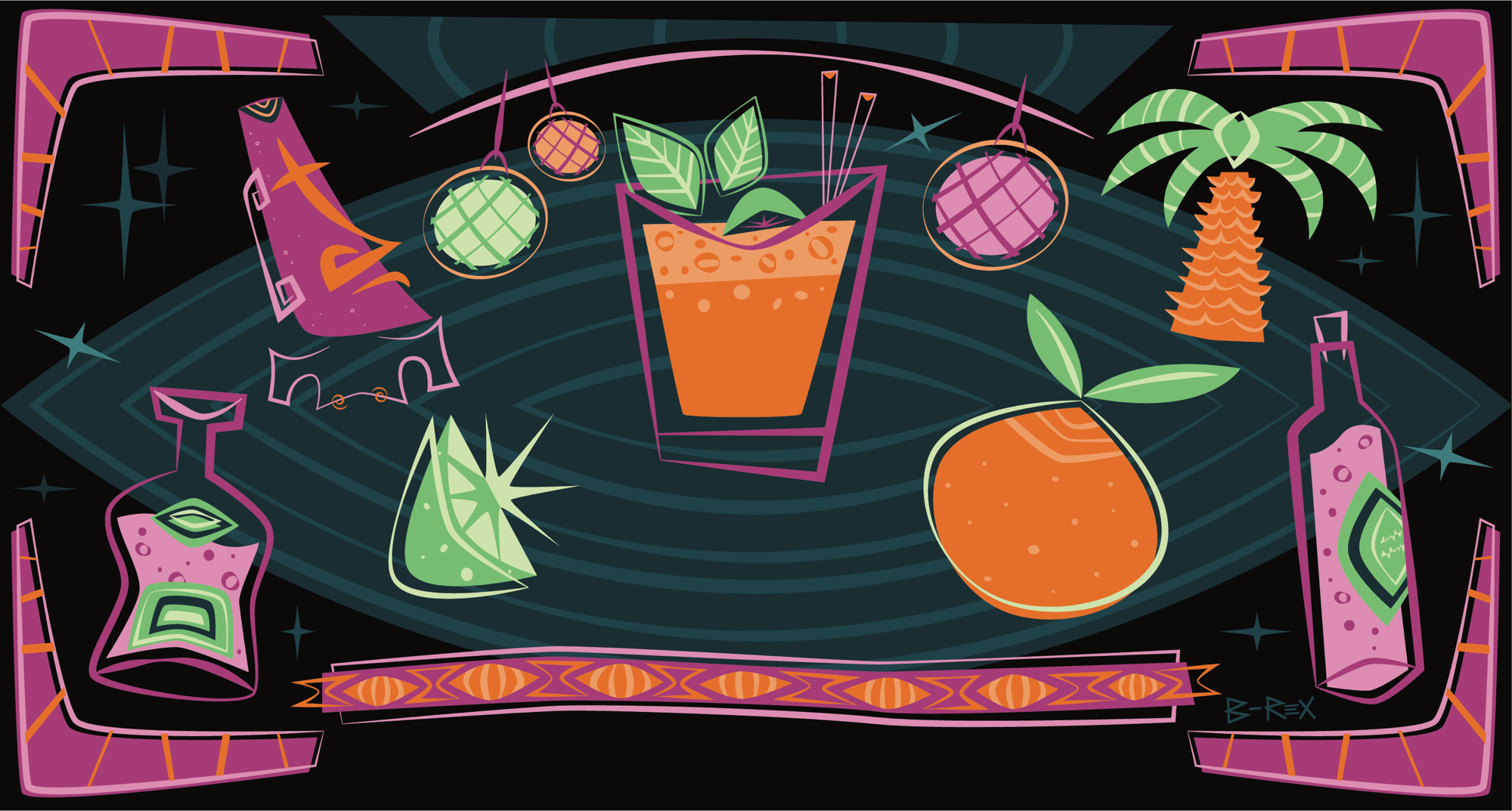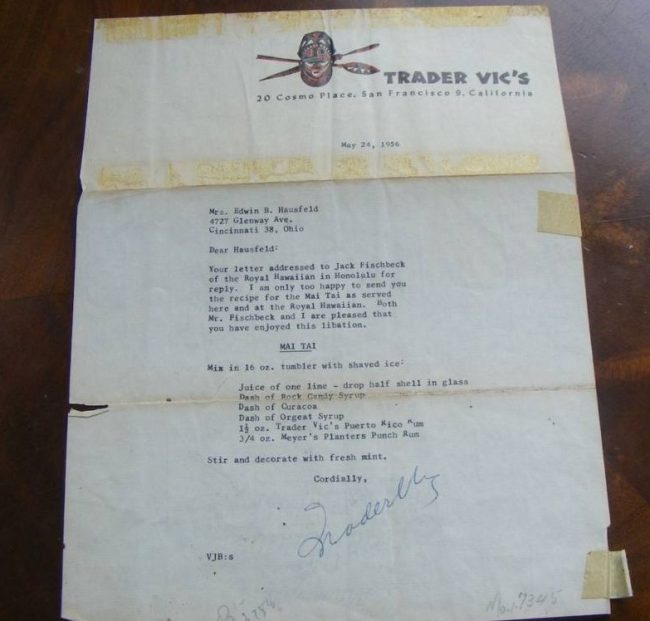When Trader Vic Bergeron included the Mai Tai on his cocktail menu for the Royal Hawaiian Hotel and Moana Hotel in 1953, he never knew the cocktail would become one of the most famous in the world. The cocktail’s exotic name and attribution as being “from Tahiti” surely helped get the drink ordered, but the taste is what made the tourists rave. Notably, there was no pineapple or orange juice in these early Hawaiian Mai Tais, and no evidence that Trader Vic ever added pineapple juice to a Mai Tai.
This style of the original Hawaiian Mai Tai was similar to the original 1944 recipe, but was adjusted to omit the long-aged rums that had been the featured spirit in the cocktail up to that point. The use of light rum in combination with a flavorful dark rum was common across all published recipes of this era, including in the recipe that Bergeron provided to a guest in a letter in 1956. This affords a lighter style to the cocktail, likely considered more refreshing and approachable for the average hotel guest.
The dark Jamaican rum of this era was not as ester-forward as what you might find today, and funky rums wouldn’t have been a good choice for tourists. So, think of something like Coruba or Myers’s rather than Smith & Cross. Rum floats were not common during this time-period, but more than two ounces of rum was used in many recipes. No wonder the tourists loved those little “tummy warmers.”
Though the recipes of this era vary, there are some common elements. Besides the use of both light and dark rum, the sweeteners were always included in equal parts.
1956 Mai Tai Recipe from Trader Vic
This is the earliest known Mai Tai recipe to come from a contemporaneous source, which was a letter that Bergeron wrote to a customer asking for the recipe. This shatters the myth that the Mai Tai recipe was somehow a secret, which deduction already tells you is impossible given that Bergeron wasn’t overseeing operations in Hawai’i.
1956 Mai Tai
Juice of One Lime
Dash of Rock Candy Syrup
Dash of Curacao
Dash of Orgeat
1½ ounces Trader Vic’s Puerto Rican Rum
¾ ounce Myers’s Plantation Punch Rum
Stir and decorate with fresh mint
Some things are immediately curious to fans of the ubiquitous 1944 recipe.
The Measurements of a “dash” each of Orgeat, Curacao, and Rock Candy Syrup? Many of you are familiar with using a “dash” of bitters in a drink and may think that this is an incorrect measurement. It turns out that there is an explanation in the 1972 Trader Vic’s Bartender’s Guide. On page 27, it says that for liquid ingredients such as syrups and juices that 1 dash = ¼ ounce.
For “Juice of one Lime” we know from Bergeron’s 1974 book Rum Cookery & Drinkery that on page 96 that it states that “Juice of one average Lime = 1 ounce.”
Bergeron specifically calls for Trader Vic’s Puerto Rican Rum – that Vic, always selling! But was this rum actually used at the Royal Hawaiian? Other recipes call for generic light Puerto Rican Rum and it seem more likely that Bacardi or Ronrico were used generally. The other rum is Meyer’s (sic) Planters Punch Rum, a popular and widely available rum. This was quite different than the Myers’s Dark Jamaican Rum you find today, notably in that it was bottled at 97 proof and 100% pot-still. I’ve tried this rum and it is much more flavorful than 80 proof dark Jamaican rums you find today and more similar to Worth Park 109.
The rum blend here is intentional, using the light rum to cut down the punchiness of the Jamaican rum and to make it much more approachable for tourists.
1958 Mai Tai from a Bartender at the Royal Hawaiian Hotel
A syndicated news story published in newspapers nationwide provided a recipe that was attributed as coming from a bartender at the Royal Hawaiian.
1958 Mai Tai
1 oz Lemon Juice
½ oz Fresh Lime Juice
⅓ oz Rock Candy Syrup
⅓ oz Orgeat
⅓ oz Orange Curacao
1 oz Light Puerto Rican Rum
1 oz Dark Jamaican Rum
Decorate the glass with a stalk of Sugar Cane, a sprig or two of Mint, and a Pineapple stick or two.
This one is quite close to the 1956 version, except there are higher proportions of juice and sweeteners. The ⅓ ounce measures for the Rock Candy, Orgeat, and Orange Curacao are most likely due to those ingredients being batched so that the bartender can more easily measure 1 ounce of sweetener.
1960s Recipes from Stan Delaplane and Ronrico Rum
Stan Delaplane published this Mai Tai recipe in his widely syndicated column in 1961, garnering many eyeballs from readers who were aware of Delaplane’s role in introducing the Irish Coffee to America. The same recipe was published by Puerto Rican rum producer Ronrico in a print ad the following year, notably pairing the light Puerto Rican rum with Myers’s Jamaica rum.
1 jigger Ronrico White
1 jigger Myers’s Jamaica Rum
Juice of One Lime
1 dash Orgeat
1 dash Simple Syrup
1 dash Orange Curacao
Note: 1 Jigger = 1½ oz
Generic Original Hawaiian Mai Tai Recipe
Looking at the recipes and how they varied, we taste tested some variants and came up with a generic version that is both representative and also easy to prepare. This version uses more sweeteners to better balance the lime and the rum.
Original Hawaiian Mai Tai (Generic)
1 oz Lime Juice
⅓ oz Orgeat
⅓ oz Rock Candy Syrup
⅓ oz Orange Curacao
1½ oz Light Rum
1½ oz Dark Jamaican Rum (ideally Worthy Park 109)
Shake with crushed ice and pour into a double-rocks glass, topping with more crushed ice. Garnish with mint or orchid, and either a pineapple spear or a speared pineapple chunk with a cherry.

The Mai Tai that Won the World
Though it is easy for people today to think about a “Hawaiian Mai Tai” being one made with pineapple juice and a huge dark rum float, the Mai Tai was notable for years before pineapple juice was added. We didn’t find any recipes in the 1950s with pineapple and the Moana and Royal Hawaiian Hotels didn’t incorporate pineapple until the 1970s.



